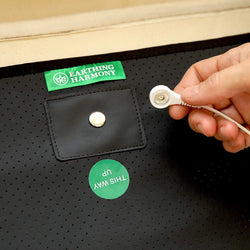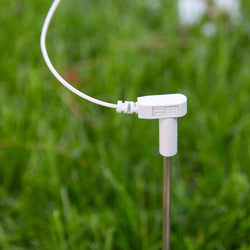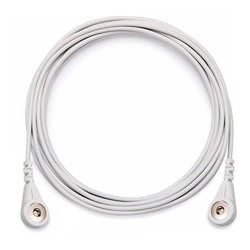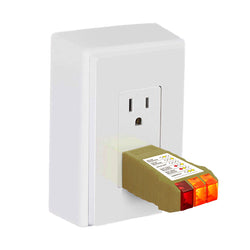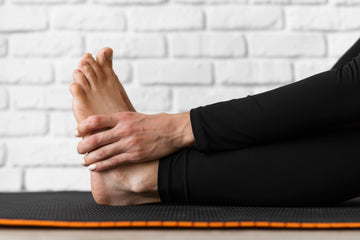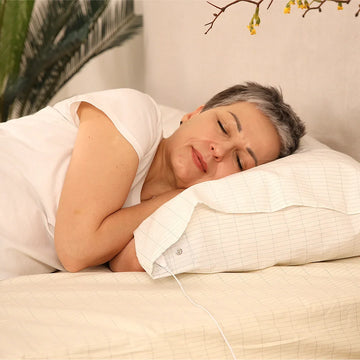Grounding can give you a vast set of natural tools and techniques to treat and ease most symptoms of anxiety without dealing with the side effects of drugs and medication. Keep reading to find out how.
Anxiety disorders impact millions of individuals annually, with at least 1 in 4 people experiencing them at some stage in their lives. While it's normal to experience anxiety before significant events such as exams, job interviews or dates, constant anxiety is debilitating and overwhelming, making it difficult to fully participate in your everyday tasks and activities.
If you're struggling with anxiety, chances are you've already explored several medications offered by traditional medicine, such as antidepressants, which are known for their potential unpleasant side effects.
That's why many people turn to natural, medication-free methods to cope with these disorders and find grounding to be a helpful practice for alleviating many symptoms of anxiety.

What Is Anxiety And How It Is Related To Stress?
Anxiety can be defined as a feeling of unease, worry, or fear about something that may happen in the future, often accompanied by physical symptoms such as increased heart rate, rapid breathing, sweating, and muscle tension.
Thought to have evolutionary origins and closely linked to stress, anxiety is, in essence, part of our natural "fight or flight" response to stressful scenarios, resulting in negative emotions having an impact on different parts of our body.
This involves the activation of our sympathetic branch of the autonomic nervous system, responsible for releasing stress hormones like adrenaline and cortisol. When we are in a dangerous situation, heart rate increases, blood is diverted to the muscles and blood sugar levels rise, providing extra energy and better response timing. Also, our body suppresses some other functions like our immune and digestive systems as a part of this process.

Once this situation is over and danger has passed, the sympathetic nervous system switches off, stabilizing adrenaline and cortisol levels while the parasympathetic nervous system kicks in allowing suppressed functions to resume.
Nevertheless, in cases of chronic stress, our sympathetic branch can become dysregulated and overly active, disrupting the balance of adrenaline and cortisol levels, while our nervous system fails to deactivate.

Which Are Anxiety's Symptoms?
Anxiety symptoms can present themselves as both emotional and physical but may vary for everyone since there is no unique state regarding this disorder.Common symptoms include insomnia, heart palpitations, digestive issues, persistent sweating, and panic attacks, among others.
Besides some serious and particular issues, there are many disorders that can be triggered by this health problem as people with this condition may experience intense, excessive and persistent worry and fear in normal life situations which can lead to out of proportion responses.
Alongside some severe complications, several conditions can be triggered by this disorder, as individuals struggling with anxiety may endure overwhelming and persistent worry and fear in typical life scenarios, which can provoke exaggerated reactions.

This includes several anxiety-related conditions such as generalized anxiety disorder (GAD), social anxiety disorder, and specific phobias like claustrophobia (fear of enclosed spaces), or agoraphobia (fear of open and public places), among others. Additionally, individuals may also experience debilitating panic attacks.
Moreover, individuals may also experience debilitating panic attacks, marked by sudden and intense episodes of fear or discomfort, often accompanied by physical symptoms such as rapid heartbeat, trembling, and shortness of breath.
Many individuals find grounding to be an effective practice for easing various anxiety symptoms, offering natural relief and promoting overall well-being.
These symptoms disrupt daily activities and may result in avoiding certain situations or environments, transforming routine tasks into daunting challenges as it becomes increasingly difficult to engage in work and social interactions. Also, the fear of experiencing another panic attack can become paralyzing, triggering preemptive anxiety and reinforcing avoidance behaviors, thus perpetuating a cycle of ongoing distress.

Why People Suffer From Anxiety?
There are many reasons. Genetic factors within your family group could be a potential cause. Perhaps you're consistently under pressure or exposed to prolonged stressful events in your line of work. Additionally, chronic illness, substance abuse, or childhood trauma might contribute to the development of anxiety.
Other physical and emotional issues like depression, insomnia and digestive orders are strongly related to this disorder. Anxiety can either be a contributing factor to many other health concerns or arise as a result of pre-existing conditions.
Also, there is an undeniable relationship between anxiety and social and environmental factors as we experience constant stress in our jobs, studies and societal pressures.
Fortunately, grounding provides a way to deal with anxiety without the risk of experiencing medication side effects or developing dependence on drugs as some treatments may induce.

What Is Grounding And How Can It Help With Anxiety?
Grounding, also known as earthing, offers a natural approach to alleviate anxiety and stress. This practice harnesses the subtle electrical charge of the Earth, providing numerous benefits that improve both our physical and emotional health.
The earth’s surface carries a negative electrical charge due to its high numbers of electrons. When your body makes conductive contact with the earth, it absorbs these electrons, which function as potent antioxidants. They effectively diminish inflammation within the body and neutralize free radicals (unstable molecules in the body that damage cells and DNA). Engaging in grounding practices can help with sympathetic nervous system overdrives, promoting balance within the autonomic nervous system and reducing overall stress levels.

Grounding also improves both the quality and duration of sleep, providing a more invigorating and extended period of rest. This, in turn, enhances daytime energy levels and restores natural biological rhythms. Also, grounding serves to normalize cortisol and adrenaline levels, as well as heart rate.
These benefits are fundamental aspects that demonstrate the healing nature of grounding, as it effectively reduces anxiety by aiding in the regulation of the nervous system, addressing insomnia and reducing stress , alongside other advantages.
Grounding offers a drug-free approach to managing anxiety, reducing the risk of medication side effects and dependency often associated with conventional treatments.
Another important aspect of grounding is its cumulative benefits, indicating that the longer you engage in grounding practices, the greater improvements you can experience in your health. Therefore, it’s beneficial to maintain a consistent grounding practice and invest time in doing so.

The traditional method of grounding typically involved walking barefoot outdoors on a conductive surface like grass, sand or rock, like our ancestors did back in their time. However, in today’s fast-paced modern lifestyle, finding the time and a serene environment for this practice can be challenging, particularly when seeking enhanced benefits from the cumulative effects of earthing.
Maximize the benefits of grounding effortlessly with a grounding sheet while you sleep. By simply resting, you can experience hours of grounding, making it an ideal and convenient method to practice at home for optimal results.
Nevertheless, there are indoor grounding products and tools that can help you maximize the positive effects of grounding within the comfort of your home, allowing you to incorporate grounding into your daily routine.

How Can I Practice Grounding At Home?
You can begin by using a grounding mat while working or engaging in other activities such as cooking or reading. Spending 10 to 40 minutes daily on our grounding mat can lead to positive changes within a few weeks.
Also, you can enjoy all the advantages of grounding while you rest by using a grounding sheet when you go to bed. This way you can ground yourself for several hours by just sleeping, which may prove to be the best method to practice grounding at home and get the most of it.
Using a grounding sheet in bed can deliver all the cumulative benefits of grounding over an 8-hour period of sleep and can also provide immediate improvements during short naps, eliminating the need for scheduled practices that may be challenging to maintain consistently.

Imagine being able to effortlessly experience all the mentioned improvements simply by following your usual nighttime sleep. This is where grounding sheets truly stand out as a tool, making a significant difference in your well-being.
Take the word of Alice, a web designer who was struggling with panic attacks and social phobia and started practicing grounding during sleep time.
“Anxiety was taking a toll on both my job and personal relationships. I had trouble sleeping and meetings really wore me off. Desperate for relief, I turned to medication, but it left me feeling numb and disconnected.
I was skeptical about grounding at first but, once I started using a sheet on my bed, I noticed a remarkable improvement in my sleep after just a few nights. Within a couple of weeks, I began to feel genuinely rested and noticeably calmer throughout my daily activities.. I couldn’t believe it at first but after doing some more research and talking to others who also practice grounding, it became evident that this was a game-changer for people like me who struggle with anxiety.”
Several tools and accessories are available to enhance the benefits of grounding, offering a convenient and practical means to incorporate grounding into your daily routine. Grounding serves as a natural and healthy lifestyle enhancement, effectively addressing multiple symptoms of anxiety.
Is There Any Scientific Evidence In Grounding?
Multiple studies have demonstrated that grounding practices can alleviate and enhance various key aspects of numerous diseases and health conditions.
In a published study from 2010, grounding demonstrated the potential to enhance heart rate variability. The research assessed parameters including respiratory rate, blood oxygenation, perfusion index, and skin conductance, all of which are indicators of autonomic nervous system activity and stress levels.
Nearly 30 healthy subjects participated in a study where they used grounding pillows, mats, and other products for a two-hour duration. The study involved alternating periods of being ungrounded for 40 minutes, followed by 40 minutes of grounding, and another 40 minutes ungrounded again.
The study found that skin conductance decreased within a few seconds of grounding, a sign of rapid change in the autonomic nervous system.

Another study, published in 2004, examined the impact of grounding on cortisol levels, pain perception, and stress levels. Twelve subjects who experienced symptoms such as insomnia, chronic stress, and anxiety slept on grounding sheets in their beds for eight weeks as part of the research.
They had their cortisol levels measured at the beginning of the study and then again when it concluded. The results revealed that the majority of participants exhibited normalized cortisol levels compared to their initial readings. Additionally, they reported enhancements in both the quality and quantity of their sleep, along with decreased stress levels and fewer symptoms of anxiety overall.

Grounding offers practical tools to address the symptoms and triggers of anxiety, making it particularly valuable for those navigating this condition. By blending ancestral wisdom with modern technology, grounding provides a natural approach to managing the challenges of contemporary life. Through grounding sheets, for example, we can nurture both our physical and mental well-being, leading to a more balanced and healthier lifestyle.
Grounding serves as a tangible and effective method for coping with anxiety. Taking the initiative to incorporate these tools into our daily routines can be a meaningful step toward finding relief and fostering resilience in the face of anxiety.







 Shoes
Shoes
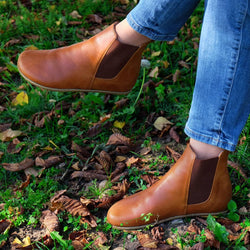 Boots
Boots
 Sandals
Sandals
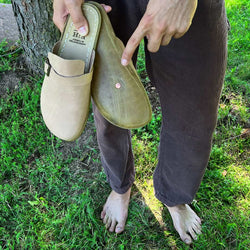
 Shoes
Shoes
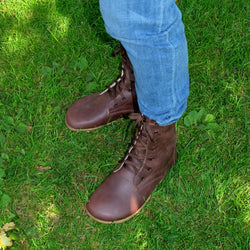 Boots
Boots
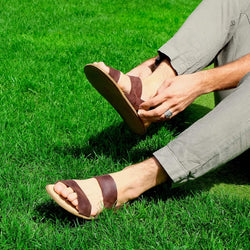 Sandals
Sandals

